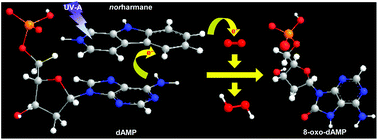Photosensitized electron transfer within a self-assembled norharmane–2′-deoxyadenosine 5′-monophosphate (dAMP) complex†
Abstract
Norharmane is a compound that belongs to a family of alkaloids called β-carbolines (βCs). These alkaloids are present in a wide range of biological systems, playing a variety of significant photo-dependent roles. Upon UV-A irradiation, βCs are able to act as efficient photosensitizers. In this work, we have investigated the photosensitized oxidation of 2′-deoxyadenosine 5′-monophosphate (dAMP) by norharmane in an aqueous phase, upon UV-A (350 nm) irradiation. The effect of the pH was evaluated on both the interactions between norharmane and dAMP in the ground and electronic excited states, and on the dAMP photosensitized oxidation. A quite strong static interaction between norharmane and dAMP was observed, especially under those pH conditions where the protonated form of the alkaloid is present (pH < 7). Theoretical studies were performed to further characterize the static complex structure. The participation of reactive oxygen species (ROS) in the photosensitized reaction was also investigated and the photoproducts were characterized by means of UV-LDI-MS and ESI-MS. All the data provided herein indicate that electron transfer (Type I) within a self-assembled norharmane–dAMP complex is the operative mechanism in the dAMP photosensitization.


 Please wait while we load your content...
Please wait while we load your content...